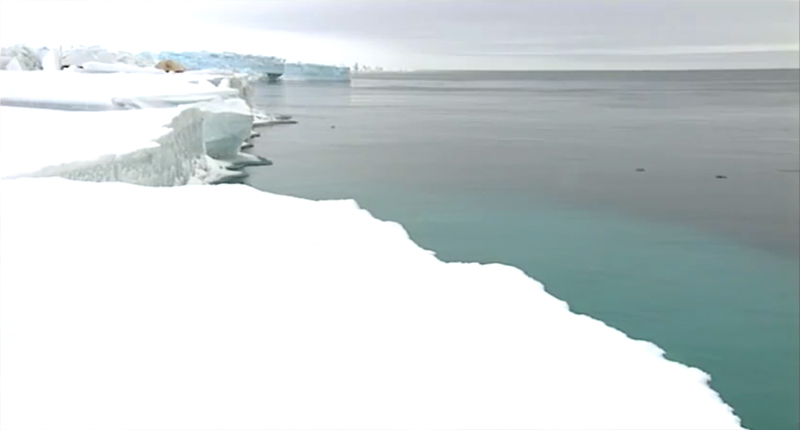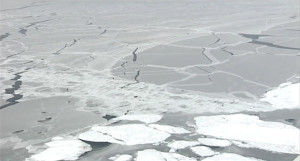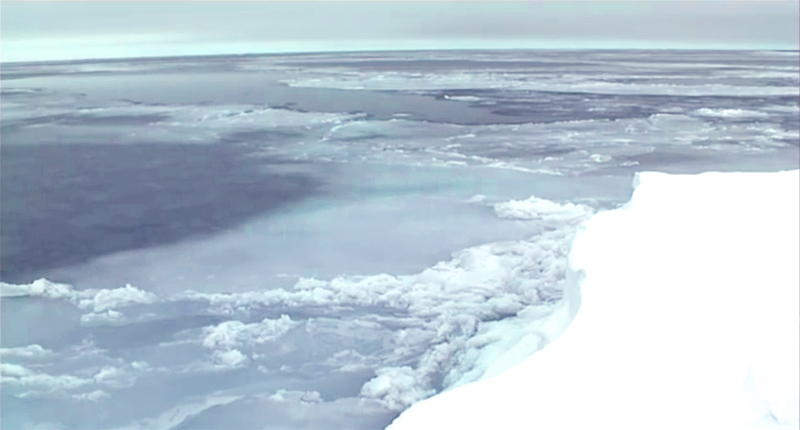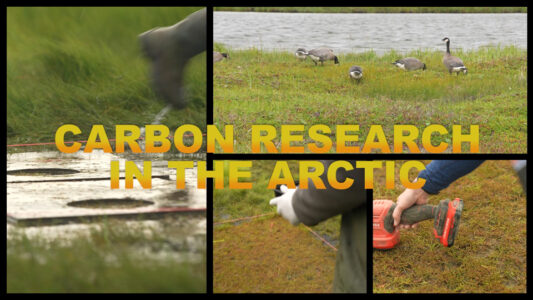
A new data set shows central Arctic Ocean sea ice thinned 65% between between 1975 and 2012. The study, authored by University of Washington Applied Physics Laboratory scientists, combined observations gathered through many means and incorporated them into a consistent format. Data came from sources including submarine-born sonar, airborne measurements, satellite imagery, and instruments moored in and around the Arctic sea ice.
During minimum ice extent in September following the sunny summer period, the data set shows central Arctic Ocean average sea ice became 85% thinner for the same 37-year period between 1975 and 2012.
While satellite imagery makes sea ice extent (area covered) fairly easy to measure, sea ice thickness poses a tougher challenge– sea ice thickness is harder to measure and to calculate than sea ice extent is. This effort combined existing observations from scattered databases to provide a standardized data set of ice thickness. The data is accessible at the Unified Sea Ice Thickness Climate Data Record hosted by the U.S. National Snow and Ice Data Center.
Modeling sea ice
Kate Hedstrom, oceanographic specialist at the Arctic Region Supercomputing Center in Fairbanks, Alaska, works to refine supercomputer-driven simulations of the Arctic Ocean. In FrontierScientists video Modeling Sea Ice in the Arctic, Hedstrom talks about crafting models of Arctic ice and water currents. She explained: “We’re funded by BOEM– the Bureau of Ocean and Energy Management. They’re interested in what the surface currents are and the surface winds and surface ice motion and they take those three fields together and they produce maps of where oil would go in the event of an oil spill.”
Simulations of sea ice near Alaska’s north shore must take into account landfast ice, ice that freezes against shore in late fall and breaks away in spring as the pack ice retreats north. Over the decades, the behavior of the landfast ice has altered. It’s not easy to predict; trends change in response to ocean currents, tides, atmospheric trends and winds, and air and water temperatures.

“The whole system up there is changing a lot,” Hedstrom outlined. “The nature of the pack ice itself has changed from being really solid and thick [] multiyear ice to being just little patches of multiyear ice with just the first-year ice in between and so it’s not as stiff as it used to be– just interesting changes going on.” She added: “But we will have ice every winter as long as it remains dark up there, I believe.”
Researching the pack ice
The long Arctic winter, when Earth’s North tilts away from the sun, can make research a real challenge. Scientists looking to study sea ice or the ocean beneath it might find passage on the U.S. Coast Guard’s icebreaker USCGC Healey, as described in this account of the 2011 Arctic Winter Cruise. A new research vessel owned by the National Science Foundation operated by the University of Alaska Fairbanks can also support scientific research in icy waters. Its name is the R/V Sikuliaq, meaning ‘young sea ice’ in the Iñupiaq language.
Scientists across the northern ocean make use of research vessels in their studies. Last December researchers aboard Norway’s R/V Lance purposefully moored in sea ice and let their vessel be frozen into the growing pack ice. By remaining in the pack ice over winter, they could use the Lance as a base from which to conduct many sea ice studies. The Norwegian Young sea ice cruise, sponsored by the Norwegian Polar Institute (NPI), was planned to allow scientists to monitor sea ice across its lifespan from late fall to early summer.
“There have been few studies of the Arctic in the winter, and none in this new type of situation in the Arctic Basin,” according to Kim Holmén, international director of the Norwegian Polar Institute.

Measuring and characterizing sea ice trends will help us predict and understand future sea ice conditions impacting sea ice dependent ecosystems, fishing and subsistence hunting activities, and travel and Arctic industries.
The new character of Arctic sea ice
Sea ice trends are changing. March 2015’s monthly sea ice average extent was the lowest in the satellite record (March ice covered the least area ever imaged from space). Similarly, September 2012 Arctic sea ice extent reached a record low. We can expect to see a continuing decline of summer sea ice. Since warm summer temperatures and warmer waters from southern oceans are reaching Arctic sea ice, more melt occurs. It leads to lessened extent and thickness. Arctic ice in general is younger (less likely to have survived multiple years), less massive, thinner, and faster moving than it tended to be in the past. According to the National Snow and Ice Data Center the satellite record shows a 2.6% decline per decade for Arctic sea ice extent.
Laura Nielsen 2015
Frontier Scientists: presenting scientific discovery in the Arctic and beyond
- ‘On thin ice: Combined Arctic ice observations show decades of loss’ Hannah Hickey, UW Today (Mar 3, 2015) http://www.washington.edu/news/2015/03/03/on-thin-ice-combined-arctic-ice-observations-show-decades-of-loss/
- ‘Norwegian Young sea ICE cruise (N-ICE2015)’ Harald Steen, Norwegian Polar Institute (Jan 1, 2014) http://www.npolar.no/en/projects/details?pid=b98886ce-590a-48a8-b113-4b96e98c65c8














